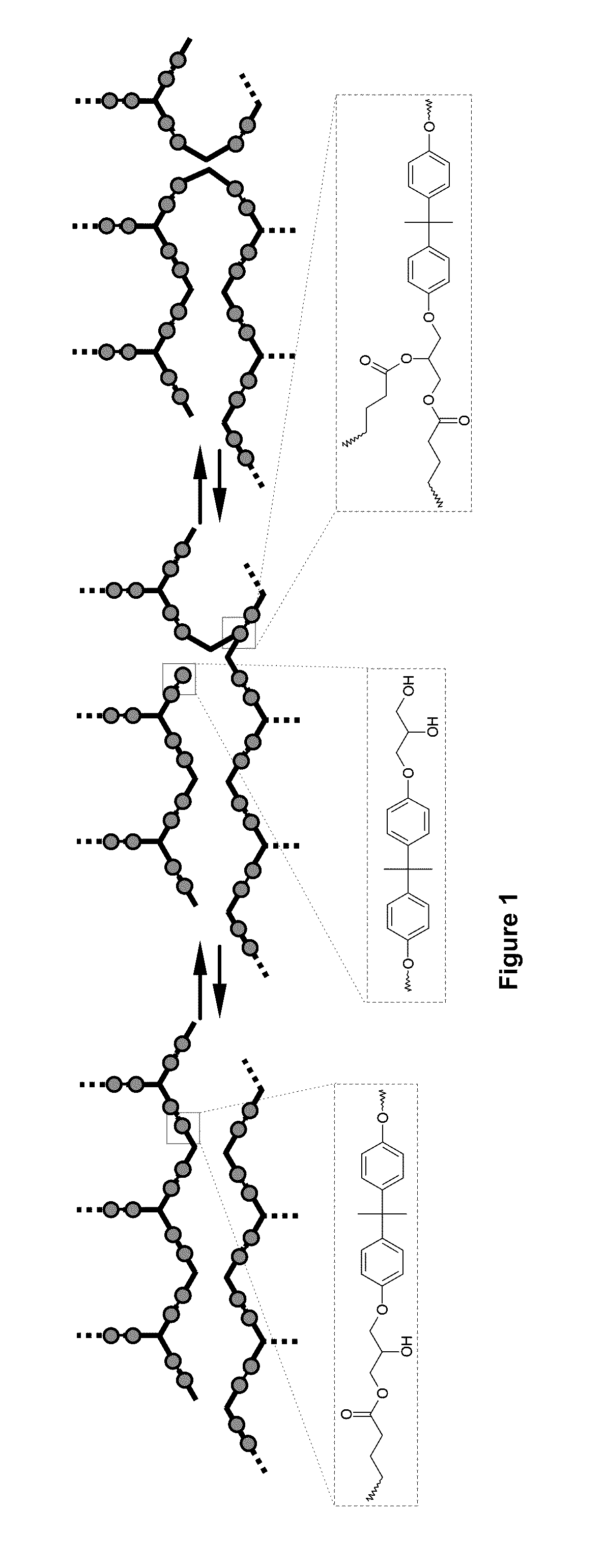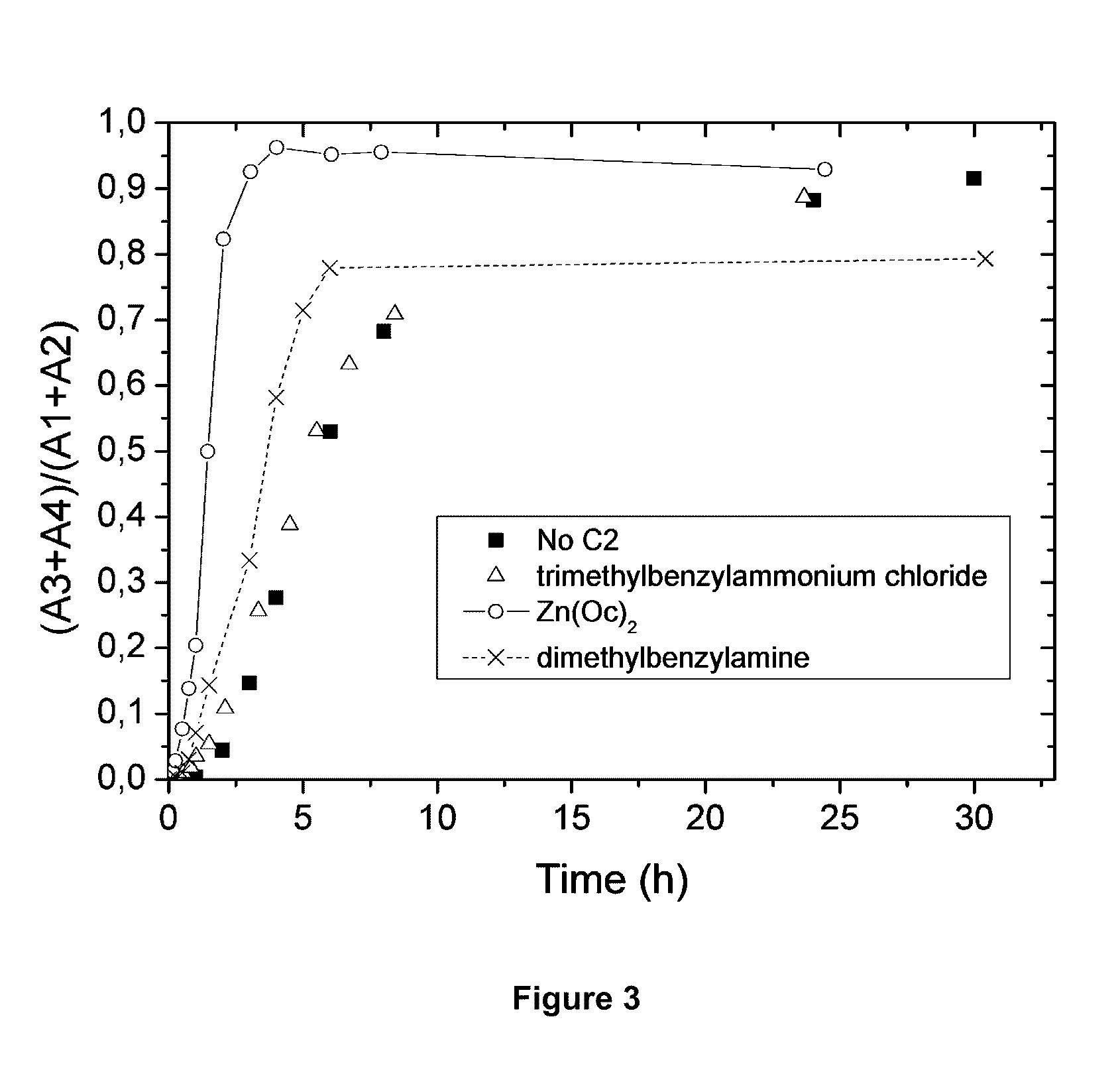Epoxy Acid Thermoset Resins and Composites that Can Be Hot-Fashioned and Recycled
a thermoset resin and thermoset composite technology, applied in the field of new products, can solve the problems of releasing polymerisable agents into fractures, microcapsule ruptures, and limited methods for repair of articles, and achieve the effect of convenient storage, transportation and handling
- Summary
- Abstract
- Description
- Claims
- Application Information
AI Technical Summary
Benefits of technology
Problems solved by technology
Method used
Image
Examples
— synthesis examples
I—Synthesis Examples
I-1 Example 1
Synthesis with Catalyst, Material (1) According to the Invention
[0237]First Step: Dissolution of the Catalyst and Ligand Exchange
[0238]20 g of Pripol® 1040 [molar mass per COOH 296 g / mol, dimer content (23%), trimer content (77%)] and 742 mg of zinc acetate dihydrate (3.47 mmol), i.e. a [Zn] / [COOH] mole ratio of 0.05, are placed in a 100 ml round-bottomed flask. The mixture is heated under vacuum in stages from 110° C. to 170° C. over 3 hours until dissolution of the catalyst grains is complete. A strong evolution of gas is observed, which confirms the loss of the acetate ligands, replaced by the fatty acids.
[0239]Second Step: Reaction with the Epoxy Resin
[0240]15.75 g of the mixture prepared in the first step are added to 9.25 g of BADGE [molar mass per epoxy 174 g / mol] (for a [COOH] / [epoxy] ratio close to 1) in a Teflon beaker. The reaction mixture is homogenised by heating (˜130° C.) with mechanical stirring. The mixture is then poured into a moul...
— example 2
II—Example 2
Repair in a Press
[0242]Samples of plates prepared according to Example I-1 and I-2 are chopped into fragments from 2 mm to 5 mm in size.
[0243]These fragments are placed in a brass mould 1.35 mm thick pierced with a circular aperture, between two sheets of non-stick paper. The assembly is then placed in a press at 150° C., for 1 hour 30 minutes, at a pressure of 5 MPa.
[0244]In the catalysed case (I-1), a circular plate of repaired material is observed, the fragments being solidly bound together and the joints being smooth and sparingly visible. In the non-catalysed case (I-2), the plate shows very little cohesion, the fragments not being bound together.
— example 3
III—Example 3
Shear Experiments
[0245]Rectangular strips 5 mm wide, 25 mm long and 1.35 mm thick are cut using a punch from a plate of material synthesized according to Example I-1 or I-2. Two strips are placed one on the other, by superposing over a length of 15 mm in accordance with FIG. 7 of standard ASTM D3983. The assembly is compressed from a thickness of 2.70 mm to a thickness of 2 mm (i.e. a compression of 26%) using a Mohr clip and 2 mm blocks.
[0246]The strips thus compressed are placed in an oven for 1 hour at a temperature of 150° C. After cooling the Mohr clip is taken off and a tensile test is performed at room temperature at a constant travelling speed (5 mm / minute) on an Instron® machine. The force is measured as a function of the displacement, which reaches its maximum just before the assembly breaks.
[0247]In the case of the sample prepared without catalyst (I-2), the maximum force is 11.8 N, whereas it is 26.8 N in the case of the sample prepared with catalyst (I-1).
PUM
| Property | Measurement | Unit |
|---|---|---|
| storage modulus | aaaaa | aaaaa |
| storage modulus | aaaaa | aaaaa |
| temperatures | aaaaa | aaaaa |
Abstract
Description
Claims
Application Information
 Login to View More
Login to View More - R&D
- Intellectual Property
- Life Sciences
- Materials
- Tech Scout
- Unparalleled Data Quality
- Higher Quality Content
- 60% Fewer Hallucinations
Browse by: Latest US Patents, China's latest patents, Technical Efficacy Thesaurus, Application Domain, Technology Topic, Popular Technical Reports.
© 2025 PatSnap. All rights reserved.Legal|Privacy policy|Modern Slavery Act Transparency Statement|Sitemap|About US| Contact US: help@patsnap.com



